|
|
|
Sort Order |
|
|
|
Items / Page
|
|
|
|
|
|
|
| Srl | Item |
| 1 |
ID:
166655
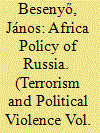

|
|
|
|
|
| Summary/Abstract |
We have heard ever more about the growing Russian presence in Africa in the past few years, which might appear strange for many people. Those, however, who know the history of the Black Continent, also know that Russian presence is not a new phenomenon. Africa was an important place during the Cold War where the Soviet Union not only competed with the United States of America, but also with China. For those who observed the robustly growing US and Chinese Africa policies, it could have appeared after the end of the classic Cold War, that the Russians had retreated beyond the borders of their country, abandoning the Black Continent in favour of their previous rivals. However, it did not happen, because the Russians did not close their diplomatic missions as they did in the former socialist countries of Eastern Europe. Furthermore, the Russians played a key role in UN Peacekeeping Missions in Africa, where they provided the necessary Air Transportation Capabilities together with the Ukrainians. Today it is becoming obvious that not only a new form of the Cold War has been resumed between the West and Russia but also the fact that the Russian “retreat” was only temporary. The relations with African countries are becoming increasingly important not only for the Russians, but also for the Africans, who need no longer choose between the American and the Chinese way of development. Even though the US and China did not view Russia as a competitor in the recent past, taking into account the events of the past few years the situation has changed. We also need to see that Russia—similarly to China—is primarily a competitor to US great power interests. China intends to cooperate with Russia, rather than competing, whilst not denying the existence of competition between the two countries. I would like to give a picture of this process in my study, including the changing balance of powers in Africa.
|
|
|
|
|
|
|
|
|
|
|
|
|
|
|
|
| 2 |
ID:
166673


|
|
|
|
|
| Summary/Abstract |
While the number of American jihadi terrorist attacks remains relatively rare, terrorist plots thwarted by law enforcement have increased since September 11, 2001. Although these law enforcement blocks of would-be terrorists are considered counterterrorism triumphs by the FBI, human rights and civil liberty watch groups have conversely suggested that those who plan for attacks alongside government informants and undercover agents may be unique and essentially dissimilar from terrorists. Underlying this debate is the empirical question of how planned yet unsuccessful attacks and their plotters compare to successful terrorist homicides and their perpetrators. The current study addresses this question by comparatively examining jihadi terrorist homicides and unsuccessful plots occurring in part or wholly on U.S. soil between 1990 and 2014. Data for this study come from the U.S. Extremist Crime Database (ECDB), an open-source database with information on terrorism and extremist crimes. Based on these data, descriptive statistics are provided for several incident, offender, and target variables across three jihadi terrorist violence categories, including homicides, plots with specified targets, and plots with non-specific targets. We find several important differences across categories of terrorist violence, suggesting that unsuccessful plotters and their intended crimes vary from their more successful terrorist counterparts.
|
|
|
|
|
|
|
|
|
|
|
|
|
|
|
|
| 3 |
ID:
166663
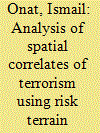

|
|
|
|
|
| Summary/Abstract |
The purpose of this study is to identify correlates of terrorism in space. It examines whether places with terrorist incidents show similar patterns with respect to the physical features across landscape, and tests the spatial influence of various features of environment on the incidence of terrorism. Drawing on the locations of violent terrorist offenses committed between 2008 and 2012, the study in Istanbul applies the Risk Terrain Modeling framework to terrorism. It uses data on police incidents and infrastructure (e.g., government buildings or parks). The analysis employs GIS techniques and an event count model, and combines all risky layers in a composite map to understand where the risk is higher. The study suggests a concentration of 1153 violent terrorist incidents relative to key physical factors by identifying seventeen potential risk factors, eight of which were significantly correlated in the model. Regardless of terrorists’ intent, the significantly associated establishments increase the risk in the surrounding areas where these features are located. The coexistence of leisure places such as bakeries, religious facilities, or eateries results in higher risks. While the environmental backcloth may constitute a risk for terrorism, its components may also help forecast the locations of terrorist incidents in the future.
|
|
|
|
|
|
|
|
|
|
|
|
|
|
|
|
| 4 |
ID:
166656
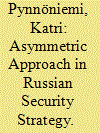

|
|
|
|
|
| Summary/Abstract |
Two observations stand out from the Russian strategic outlook. First, it corresponds with the real politik vision of world politics where the states engage in (zero-sum) competition for power and resources. Second, the new world order emerges because of a conflict between different models of development and value systems. These two observations highlight a certain “family resemblance” between the current Russian assessment of the current security environment and the situation during the Cold War. Furthermore, Russian national security strategy is oriented toward achieving strategic stability with the other great powers. The maintenance of strategic parity (nuclear and conventional deterrence) is a means to this end. However, given Russia’s relative weakness in comparison to its major geopolitical competitors, this has led to the renewal of the Cold War-era concept of asymmetric approach. Although this concept is most often used in the context of nuclear deterrence and the debate on “strategic stability,” it is not about military security only. The set of asymmetric measures from economic dependence or sanctions, to diplomatic, political, and informational measures are used to prevent an emergence of a conflict that would threaten Russia’s sovereignty and domestic stability. The purpose of this paper is to explore the Soviet roots of Active Measures and how the Soviet heritage is present at both the theoretical level and in concrete practices. Finally, insights from the conceptual analysis are applied in assessing the vulnerability of the Nordic countries, in particular Finland and Sweden, to Russian influence operations.
|
|
|
|
|
|
|
|
|
|
|
|
|
|
|
|
| 5 |
ID:
166667
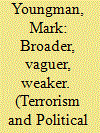

|
|
|
|
|
| Summary/Abstract |
In October 2007, veteran Chechen field commander Dokka Umarov proclaimed the formation of the Caucasus Emirate (IK), formalising the victory of the North Caucasus insurgency’s Islamist wing over its nationalist-separatists. During Umarov’s time as leader, the North Caucasus experienced sustained violence and the IK claimed responsibility for multiple terrorist attacks in and beyond the region. However, despite the importance of ideology in understanding insurgent behaviour, the IK’s ideology and Umarov’s role in shaping it remain understudied. Using Social Movement Theory’s concept of framing to analyse Umarov’s communiqués throughout his lengthy tenure (June 2006–September 2013), this article identifies three distinct phases in Umarov’s ideological positioning of the insurgency: nationalist-jihadist (June 2006–October 2007); Khattabist (October 2007–late 2010); and partially hybridised (late 2010–September 2013). The article contributes to debates over typologies of jihadist actors by highlighting the difficulties in applying them to the North Caucasus and provides a clearer understanding of the IK’s ideological transformation and the limits to its engagement with external actors. The article also illustrates that weakness was a key factor in explaining that transformation and identifies several avenues for research that could further enhance our understanding of the IK’s ideology and the role it plays.
|
|
|
|
|
|
|
|
|
|
|
|
|
|
|
|
| 6 |
ID:
166668
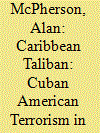

|
|
|
|
|
| Summary/Abstract |
Most scholars have not taken Cuban-American terrorism in the 1970s seriously, despite the unprecedented campaign of terror it unleashed. Borrowing a framework of self-identity usually applied to other terrorist groups and using case studies of the Cuban Nationalism Movement in New Jersey and of Alpha 66 in Florida, this article argues that Cuban-American political ideology was the key to its impact and its support from communities in Florida and New Jersey. Militant exiles saw themselves as betrayed by two enemy states, entitled to rule in their homeland, and imbued with a mission of civilizational renewal. In these ways, Cuban-American terrorists were similar to the Taliban in Afghanistan and their reign of terror in the 1970s should be appreciated as a major episode in the history of U.S. and global terrorism.
|
|
|
|
|
|
|
|
|
|
|
|
|
|
|
|
| 7 |
ID:
166677
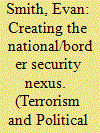

|
|
|
|
|
| Summary/Abstract |
This article looks at an earlier episode in the history of the UK border security apparatus by examining how the immigration control system was used in the 1970s and 1980s to detect potential terrorists from the Middle East and North Africa. Using recently opened archival records, it shows that the UK government introduced a strict system of visa checks, interviews, and other measures to nearly all Middle Eastern and North African visitors to the UK to prevent the entry of suspected terrorist personnel. By using these highly arbitrary measures, it became the modus operandi of the UK authorities to treat all Middle Eastern and North Africans as potential terrorists until convinced otherwise.
|
|
|
|
|
|
|
|
|
|
|
|
|
|
|
|
| 8 |
ID:
166674
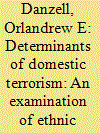

|
|
|
|
|
| Summary/Abstract |
Many scholars have sought to explain why countries with ethnically heterogeneous populations experience higher levels of political violence, but these studies have produced mixed findings. Unlike most studies that use ethno-linguistic fractionalization indices to examine this relationship, we argue that ethnic polarization is a more appropriate measure to assess the role of ethnicity as a causal factor of domestic terrorism. This paper hypothesizes that high ethnic polarization influences the incidence of domestic terrorism, particularly when intervening economic factors are present. To test three hypotheses, we use negative binomial regression to model data from the Global Terrorism Dataset, World Bank, and the Reynal-Querol (RQ) ethnic polarization index of 116 countries between 1970 and 2012. Our findings show that terrorism is more likely to emerge in societies with high ethnic polarization and economic malaise.
|
|
|
|
|
|
|
|
|
|
|
|
|
|
|
|
| 9 |
ID:
166678


|
|
|
|
|
| Summary/Abstract |
Fear is an integral part of terrorism. Fighting fear can thus be a crucial part of counterterrorist policies. In the case of terrorism, citizens look to the state for protection. Yet, most studies of terrorist fear emphasize individual-level factors. We lack studies that link fear to features of the state, especially whether democratic states are capable of reducing fear among its citizens. Our study aims to fill part of this research gap by asking whether democratic government reduces or increases fear of terrorism. We find that there is substantial cross-country variance in citizens’ fear of terrorism. The results suggest that fear is more widespread among citizens in non-democratic countries compared to citizens in democratic countries. Actual exposure to terrorist attacks has no impact on citizens’ fear of terrorism when we account for whether the country is a democracy or not. Hence, democratic government displays resilience towards fear mongering.
|
|
|
|
|
|
|
|
|
|
|
|
|
|
|
|
| 10 |
ID:
166662
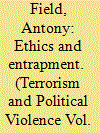

|
|
|
|
|
| Summary/Abstract |
This article examines domestic counterterrorism sting operations in the USA. It considers why critics consider these operations unethical and illegitimate. In particular, it looks at claims that counterterrorism sting operations have entrapped innocent people. This article explains why the U.S. courts have rejected claims of entrapment. It discusses different standards of entrapment used by the U.S. courts and sets out how these standards apply to counterterrorism sting operations. The article will show how key pieces of evidence convinced the courts that the targets of sting operations were predisposed towards terrorism. As a result, defendants were not able to mount successful entrapment defenses. By the end of the article, the reader will have a better understanding of the ethical and legal safeguards governing counterterrorism sting operations in the USA.
|
|
|
|
|
|
|
|
|
|
|
|
|
|
|
|
| 11 |
ID:
166671
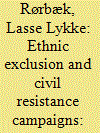

|
|
|
|
|
| Summary/Abstract |
Previous research has argued that political inequality between ethnic groups increases the likelihood of both nonviolent and violent protest. In this study, I focus on civil resistance campaigns and argue that the probability that these large-scale, organized movements will take violent over nonviolent forms increases with the share of a country’s population that is excluded from political power on the basis of ethnic affiliation. I expect this to be so because ethnically exclusive regimes are more likely to counter political demands with violent repression, which increases the cost and decreases the anticipated success of nonviolent relative to violent resistance. I test this proposition in a global sample of countries for the period 1950–2006 and find, first, that high levels of ethnic exclusion make civil resistance campaigns more likely to occur violently than nonviolently. Next, to assess the mechanism at play, I conduct a mediation analysis and show that almost half of the effect of ethnic exclusion on violent campaign onset is mediated by the latent level of violent repression in a country. This result suggests that political authorities’ repressive strategies are key to explaining why regime opponents do not always opt for nonviolent forms of civil resistance.
|
|
|
|
|
|
|
|
|
|
|
|
|
|
|
|
| 12 |
ID:
166669
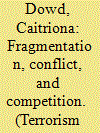

|
|
|
|
|
| Summary/Abstract |
In spite of the shared high profile of recent Islamist attacks on civilians in sub-Saharan Africa, patterns of anti-civilian violence differ across and within violent Islamist groups, and the countries in which they are active. This research seeks to explain this variation by situating Islamist violence within the sub-national spaces in which such groups operate, and the wider conflict environment in which they choose to use, or limit the use of, anti-civilian violence. Drawing on data from the Armed Conflict Location & Event Dataset, the research finds that violent Islamist groups are more likely to target civilians where they are the most active conflict agent, even when other conflict agents are active in the same spaces; but less likely to do so when they are relatively weak and in competition with other non-state armed groups. Anti-civilian violence is thus deployed strategically by violent Islamist groups, while its function as a signalling or retributive policing tool depends on the relative strength of groups in relation to actors in the wider conflict arena.
|
|
|
|
|
|
|
|
|
|
|
|
|
|
|
|
| 13 |
ID:
166653


|
|
|
|
|
| Summary/Abstract |
This short essay aims at shedding some light on the use of lawfare as an emerging domain of full spectrum warfare which can either be used in its own right to achieve its own strategic objectives or as an enabler within the context of influencing the adversary in connection with well-planned Info-Ops and Stratcom operations. The authors conclude that considering the law as a domain, the use of lawfare is an “Offset Strategy,” which will provide a considerable competitive advantage in the proper offensive and defensive applicability of law which will prevent potential adversaries to abuse the rule of law to achieve their own strategic objectives.
|
|
|
|
|
|
|
|
|
|
|
|
|
|
|
|
| 14 |
ID:
166670
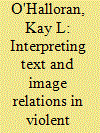

|
|
|
|
|
| Summary/Abstract |
This article presents a mixed methods approach for analysing text and image relations in violent extremist discourse. The approach involves integrating multimodal discourse analysis with data mining and information visualisation, resulting in theoretically informed empirical techniques for automated analysis of text and image relations in large datasets. The approach is illustrated by a study which aims to analyse how violent extremist groups use language and images to legitimise their views, incite violence, and influence recruits in online propaganda materials, and how the images from these materials are re-used in different media platforms in ways that support and resist violent extremism. The approach developed in this article contributes to what promises to be one of the key areas of research in the coming decades: namely the interdisciplinary study of big (digital) datasets of human discourse, and the implications of this for terrorism analysis and research.
|
|
|
|
|
|
|
|
|
|
|
|
|
|
|
|
| 15 |
ID:
166654


|
|
|
|
|
| Summary/Abstract |
During and after Ukraine’s celebrated Euromaydan (literally: European Square) Revolution of 2013–2014, a whole number of novel Ukrainian political and societal phenomena emerged. One of the most intriguing was the relatively spontaneous and government-supported emergence of volunteer armed units from late spring 2014 onwards, in connection with the start of Russia’s covert paramilitary intervention in Eastern Ukraine. Among the most widely noted of these initially irregular detachments was the “Azov” battalion or regiment, named after the Azov Sea, created, in May 2014, by an obscure lunatic fringe group of racist activists. This paper briefly sketches the origins of Azov, biographies of some of its founders, and particulars of its creation, without touching upon such issues as Azov’s military performance, later integration into the National Guard under Ukraine’s Ministry of Interior, and political development after 2014.
|
|
|
|
|
|
|
|
|
|
|
|
|
|
|
|
| 16 |
ID:
166665
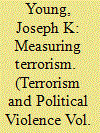

|
|
|
|
|
| Summary/Abstract |
In the conceptual literature on terrorism, there is no shortage of answers to the question: “What is terrorism?” Indeed, the terrorism literature has been heavily criticized for a deluge of definitions. And yet the booming quantitative terrorism literature generally examines a narrow set of “what is terrorism?”: how country-level factors explain variation in the number of terrorist attacks. This article demonstrates the variety of ways in which scholars currently operationalize terrorism and compares them to the ways it could be operationalized. I replicate studies using alternative operationalizations of terrorism to examine the consequences of the terrorism literature’s collective bet to focus on attack counts at the country level. Finally, I discuss the implications of the narrow set of operational choices with an eye towards how a greater variety of approaches would produce a more robust research agenda.
|
|
|
|
|
|
|
|
|
|
|
|
|
|
|
|
| 17 |
ID:
166660
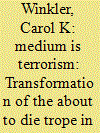

|
|
|
|
|
| Summary/Abstract |
Daesh’s ability to successfully recruit foreign fighters from more than one hundred countries worldwide raises the importance of understanding the group’s strategic media campaign. Recognizing that visual images, in particular, often increase viewers’ attention, recall, and emotional response, this study of Daesh’s official magazine, Dabiq, moves beyond earlier studies primarily focused on the magazine’s textual content to analyze the group’s visual communication strategy. This study’s content analysis of the 1,144 images appearing in the magazine’s first twelve issues reveals how Dabiq has relied extensively on a historic American media trope, the about to die image, to bolster image recirculation over time. This essay examines both the form and content of Dabiq’s use of three about to die image types as they have evolved across the twelve issues. Rather than seek to win the “hearts and minds” of the Muslim public, Dabiq’s use of about to die images transforms the online medium into terrorism in ways that have lasting implications for the global culture.
|
|
|
|
|
|
|
|
|
|
|
|
|
|
|
|
| 18 |
ID:
166650
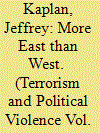

|
|
|
|
|
| Summary/Abstract |
Before there was hybrid warfare or its more innocuously styled component information warfare, there were Soviet Active Measures (Aктивные мероприятия). Conceived in 1948 and fully implemented by the 1970s, Active Measures were a palate of techniques designed to both deceive the West and to turn Western public opinion toward whatever the Soviet policy of the moment might be. “More East than West” presents a brief introduction to the Active Measures program which is followed by a single case study, that of the World Council of Churches (WCC). The image of the World Council of Churches as a Cold War pawn of the Soviet Union has become set in the American popular consciousness. It was not always so. At its birth in 1948, the WCC was seen as a promising ecumenical experiment that might serve to better unite the Christian churches of the world. Its birth, however, coincided precisely with the emergence of the Cold War and the organization was soon dragged kicking and screaming into the conflict. The Americans in the era of President Harry S. Truman saw in the group a potential ally for the Roman Catholic Church in erecting a spiritual barricade against the encroachment of atheistic communism. After 1961, the Soviets saw the group as a useful conduit for propaganda messages as designed by the Active Measures program that designed and disseminated Soviet propaganda throughout the Cold War. In the end, Soviet influence came to dominate the group’s political positions, but it never became an actual front group and successive American Presidents carried on a range of relationships with the WCC. This article offers a history of the early years of the Cold War struggle over the soul of the WCC.
|
|
|
|
|
|
|
|
|
|
|
|
|
|
|
|
| 19 |
ID:
166661
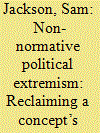

|
|
|
|
|
| Summary/Abstract |
Political extremism suffers from a definitional deficiency. This article proposes an analytical definition of the term, which avoids using extremism in a pejorative way. This definition also avoids exclusive focus on violence. This definition encourages the analyst to explicitly make the case for defining an action or an actor as extremist by comparing the action or actor to its political context. The article then explores several dimensions of an extremist political identity that can help observers understand extremist behavior and goals. It uses this conceptual framework to consider three examples of political extremism. Finally, the article concludes with some limitations and strengths of this definition of political extremism.
|
|
|
|
|
|
|
|
|
|
|
|
|
|
|
|
| 20 |
ID:
166658


|
|
|
|
|
| Summary/Abstract |
As of today, a highly mobilized Kurdish diaspora and its most prominent representative, the Kurdistan Workers’ Party (PKK), has become so influential in the European political arena that it might tip the balance of the European Union’s policies on Turkey in its favor. Since too much attention has been given to the PKK’s activities in Germany, the organization’s actions in Britain remain understudied, despite the fact that Britain has been a vital place in Kurdish politics and political lobbying activities. Drawing on fieldwork findings, this article attempts to explore both the evolution and the political activities of the PKK in Britain across three different timeframes, from 1984 until the present time. Our findings suggest that in Britain, the PKK has departed in recent years from its conventional terrorist activities and transformed into a lobbying power that is likely to gain full legitimacy (i.e., being de-listed from terrorist organization lists) in the near future.
|
|
|
|
|
|
|
|
|
|
|
|
|
|
|
|
|
|
|
|
|